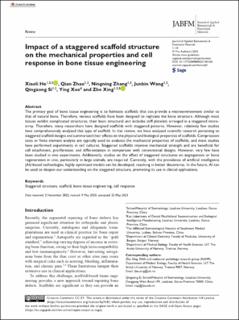| dc.description.abstract | The primary goal of bone tissue engineering is to fabricate scaffolds that can provide a microenvironment similar to that of natural bone. Therefore, various scaffolds have been designed to replicate the bone structure. Although most tissues exhibit complicated structures, their basic structural unit includes stiff platelets arranged in a staggered micro-array. Therefore, many researchers have designed scaffolds with staggered patterns. However, relatively few studies have comprehensively analyzed this type of scaffold. In this review, we have analyzed scientific research pertaining to staggered scaffold designs and summarized their effects on the physical and biological properties of scaffolds. Compression tests or finite element analysis are typically used to evaluate the mechanical properties of scaffolds, and most studies have performed experiments in cell cultures. Staggered scaffolds improve mechanical strength and are beneficial for cell attachment, proliferation, and differentiation in comparison with conventional designs. However, very few have been studied in vivo experiments. Additionally, studies on the effect of staggered structures on angiogenesis or bone regeneration in vivo, particularly in large animals, are required. Currently, with the prevalence of artificial intelligence (AI)-based technologies, highly optimized models can be developed, resulting in better discoveries. In the future, AI can be used to deepen our understanding on the staggered structure, promoting its use in clinical applications. | en_US |

